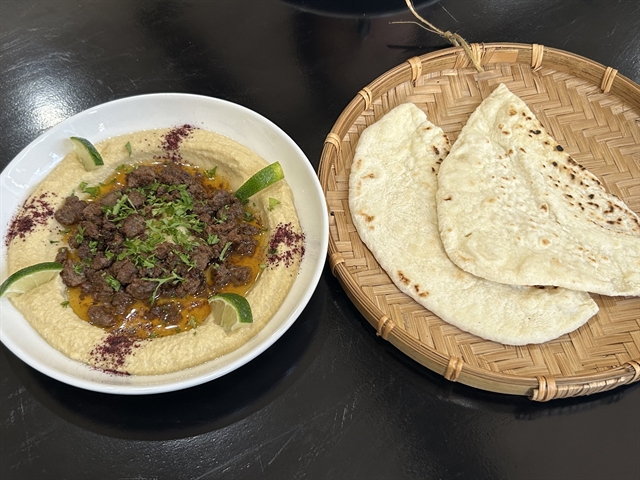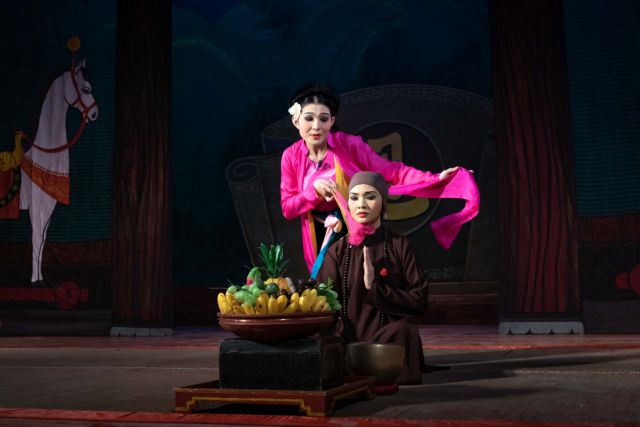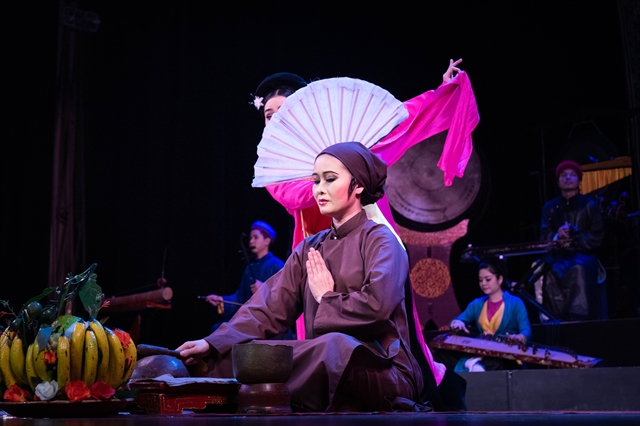 Sunday/Weekend
Sunday/Weekend

Lan Chi Hà *
As a kid, I always associated the image of my grandmother busily carrying pots and pans around the kitchen with the whimsical melodies she would hum, melodies that I never thought to ask her about.
I’ve always known that I was born into a family with a longstanding artistic tradition, where my grandparents and generations before them devoted their lives to the traditional Vietnamese stage art.
Yet for a long time, I’ve regarded chèo, an age-old art form, as something seemingly having no place in today’s globalising world where I, alongside many young Vietnamese, was captivated instead by the catchy beats and dazzling glamour of modern music.
But as I grew older and became more conscious of social issues around me, I was surprised to discover that, contrary to my earlier prejudice, underneath its lilting melodies and layered verses, chèo had long served as a medium for artists of the past to voice political criticism and expose the injustices of a cruel and corrupt society.
Above all, chèo artists dared to challenge the feudal construction of femininity by pioneering female characters who dared to love, dared to desire, and dared to reclaim their autonomy from a society that sought to confine them.
 |
| Thị Mầu, a flirtatious village girl (standing), courts Kính Tâm (sitting), who is disguised as a novice monk, after mistaking “him” for a man. Photos courtesy of Nguyễn Hoàng |
Arguably, the lead character who most vividly embodies this notion is Thị Mầu in the chèo play Quan Âm Thị Kính (Thị Kính, the Goddess of Mercy). In traditional Vietnamese theatre art – during the feudal era and even to this day – very few female characters have been portrayed as so free-spirited and openly lustful as Thị Mầu. Yet she isn’t a calculating woman, for Thị Mầu is simply driven by an intense desire to love and to be loved.
If Vietnamese women in the past were taught to strictly adhere to the "four traditional virtues of a woman: diligent work, graceful appearance, proper speech, and moral conduct", then Thị Mầu boldly cast aside all that was considered those expected ideals. She allowed herself to live according to her heart’s desires, paying no mind to social judgements or spiteful gossip.
Upon first seeing Thị Kính, who was living disguised as a male, Thị Mầu unabashedly, and some might argue blasphemously, exclaimed, “Sisters, who is this person, beautiful as a shooting star, that I saw at this temple?”
This single line reveals a passion and yearning for romantic love common among young women – a natural emotional impulse – yet one the feudal society deemed immodest and demanded women choke down.
Thị Mầu appears as a fresh gust of wind breathing vitality into the suffocating life of Vietnamese women in the past, allowing them, though it may only be for brief moments of escapism – a glimpse into their truer selves, fiery and instinctive.
 |
From a feminist perspective, Thị Mầu stands as a character centuries ahead of her time, especially in an era when feudal Vietnamese society was still heavily influenced by Confucian ideals, which largely objectified women, deeming them to be passive subjects of desire while forbidding them from desiring in return.
The audacity of chèo artists to create a female character who so boldly defied the gendered social expectations of her time made Thị Mầu a forerunner of women’s rights advocacy, both in traditional art and within the broader trajectory of Vietnamese history.
Moreover, contrary to the common misconception that conservative culture is dominant across Asia, through Thị Mầu, Vietnamese artists demonstrated an exceptionally progressive understanding of gender roles, even outpacing many contemporary Western societies, by daring to advocate for issues such as sexual autonomy – a topic that still faced social taboo in the West at the time.
 |
Even now, I remain astonished by the vision and pioneering spirit expressed in chèo, a form so far ahead of its time. As a woman, I feel an even deeper admiration when I see how artists of the past recognised and dared to voice the harsh realities of women’s lives and condemn the injustices they endured – something that even modern society continues to struggle with today.
Looking back, what moves me most is not only the artists’ vision for social equality, but also the fact that, amidst times of turmoil and uncertainty, my grandmother, generations before her, and countless other chèo artists dared to stand up and advocate for a social vision they knew to be just.
I believe that, during those days, artists played a significant role in shaping society’s perception of women at the time, and through art, offered women a sense of solace and emancipation, comfort in knowing they were seen, understood, and supported by those who dared to stand with them.
Now, whenever I hear the melodies my grandmother absentmindedly hums, I am reminded of generations of artists in my family who turned their talent, creativity, and unwavering belief in truth into instruments of social change – helping to shape the life that I, along with many young people today, am privileged to inherit. VNS
 |
* Lan Chi Hà has authored a research paper titled "Weaponisation of Feminist Rhetoric", which explores the use of feminist rhetoric in political agendas across different historical contexts. She also has contributed to research on the impact of media violence on adolescents, showcasing her commitment to understanding complex social issues.
In addition to her academic pursuits, Chi is an accomplished writer and translator, having participated in prestigious creative writing programmes and translated notable works for prominent publishing houses. She actively engages in community service, co-founding the Embers Community, which aims to improve educational access in mountainous regions, and has helped raise substantial funds for local schools.
Quan Âm Thị Kính (Thị Kính, the Goddess of Mercy) is one of the most celebrated chèo (traditional Vietnamese opera) plays, telling a tragic yet deeply moral story about compassion, injustice, and redemption. The play follows Thị Kính, a virtuous young woman falsely accused of attempting to kill her husband while trimming his beard. Cast out by her in-laws, she disguises herself as a man and becomes a novice monk under the name Kính Tâm. In the temple, she endures further suffering when Thị Mầu, a flirtatious village girl, mistakes her for a man and becomes pregnant, later blaming “Kính Tâm” for the child. Despite her innocence, Thị Kính accepts the unjust punishment in silence and raises the child with kindness. After her death, her true identity is revealed, and she is deified as Quan Âm—the Goddess of Mercy—symbolising boundless compassion, self-sacrifice, and the triumph of virtue over cruelty and misunderstanding.